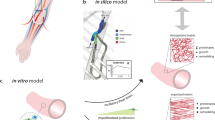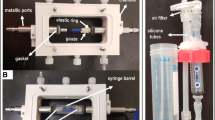Abstract
In vitro perfusion systems have exposed vascular constructs to mechanical conditions that emulate physiological pulse pressure and found significant improvements in graft development. However, current models maintain constant, or set pulse/shear mechanics that do not account for the natural temporal variation in frequency. With an aim to develop clinically relevant small diameter vascular grafts, these investigations detail a perfusion culture model that incorporates temporal pulse pressure variation. Our objective was to test the hypothesis that short-term variation in heart rate, such as changes in respiratory activity, plays a significant role in vascular remodeling and graft development. The pulse rate of a healthy volunteer was logged to model the effect of daily activities on heart rate. Vascular bioreactors were used to deliver perfusion conditions based on modeled frequencies of temporal pulse variability, termed Physiologically Modeled Pulse Dynamics (PMPD). Acellular scaffolds derived from the human umbilical vein were seeded with human vascular smooth muscle cells and perfused under defined pulsatile conditions. vSMC exposed to constant pulse frequencies expressed a contractile phenotype, while exposure to PMPD drove cells to a synthetic state with continued cell proliferation, increased tensile strength and stiffness as well as diminished vasoactivity. Results show the temporal variation associated with normal heart physiology to have a profound effect on vascular remodeling and vasoactive function. While these models are representative of vascular regeneration further investigation is required to understanding these and other key regulators in vSMC phenotype switching in non-pathological or wound healing states. This understanding has important clinical implications that may lead to improved treatments that enhance vessel regeneration.









Similar content being viewed by others
References
Abousleiman, R. I., Y. Reyes, P. McFetridge, and V. Sikavitsas. The human umbilical vein: a novel scaffold for musculoskeletal soft tissue regeneration. Artif. Organs 32:735–741, 2008.
Buttafoco, L., P. Engbers-Buijtenhuijs, A. A. Poot, P. J. Dijkstra, I. Vermes, and J. Feijen. Physical characterization of vascular grafts cultured in a bioreactor. Biomaterials 27:2380–2389, 2006.
Dahan, N., G. Zarbiv, U. Sarig, T. Karram, A. Hoffman, and M. Machluf. Porcine small diameter arterial extracellular matrix supports endothelium formation and media remodeling forming a promising vascular engineered biograft. Tissue Eng. Part A 18:411–422, 2012.
Daniel, J., K. Abe, and P. S. McFetridge. Development of the human umbilical vein scaffold for cardiovascular tissue engineering applications. ASAIO J. 51:252–261, 2005.
Dardik, A., L. Chen, J. Frattini, H. Asada, F. Aziz, F. A. Kudo, et al. Differential effects of orbital and laminar shear stress on endothelial cells. J. Vasc. Surg. 41:869–880, 2005.
Davies, P., and S. Tripathi. Mechanical stress mechanisms and the cell. An endothelial paradigm. Circ Res. 72:239–245, 1993.
Dull, R. O., and P. F. Davies. Flow modulation of agonist (atp)-response (Ca2+) coupling in vascular endothelial cells. Am. J. Physiol. Heart C 261:H149–H154, 1991.
Fisher, J. P., A. G. Mikos, and J. D. Bronzino. Tissue Engineering. Boca Raton: CRC Press, 2007.
Isenberg, B., C. Williams, and R. Tranquillo. Endothelialization and flow conditioning of fibrin-based media-equivalents. Ann. Biomed. Eng. 34:971–985, 2006.
Kozai, T., M. Eto, Z. Yang, H. Shimokawa, and T. F. Lüscher. Statins prevent pulsatile stretch-induced proliferation of human saphenous vein smooth muscle cells via inhibition of rho/rho-kinase pathway. Cardiovasc. Res. 68:475–482, 2005.
Lehoux, S., and A. Tedgui. Cellular mechanics and gene expression in blood vessels. J. Biomech. 36:631–643, 2003.
Li, C., and Q. Xu. Mechanical stress-initiated signal transductions in vascular smooth muscle cells. Cell. Signal. 12:435–445, 2000.
Lu, D., and G. S. Kassab. Role of shear stress and stretch in vascular mechanobiology. J. R. Soc. Interface 8:1379–1385, 2011.
McFetridge, P. S., K. Abe, M. Horrocks, and J. B. Chaudhuri. Vascular tissue engineering: bioreactor design considerations for extended culture of primary human vascular smooth muscle cells. ASAIO J. 53:623–630, 2007.
McFetridge, P. S., and J. B. Chaudhuri. Design of vascular graft bioreactors. In: Bioreactors for Tissue Engineering. Springer, 2005, pp. 269–283.
Montoya, C. V., and P. S. McFetridge. Preparation of ex vivo-based biomaterials using convective flow decellularization. Tissue Eng. Part C 15:191–200, 2009.
Muto, A., L. Model, K. Ziegler, S. D. Eghbalieh, and A. Dardik. Mechanisms of vein graft adaptation to the arterial circulation: insights into the neointimal algorithm and management strategies. Circ. J. 74:1501–1512, 2010.
Neff, L. P., B. W. Tillman, S. K. Yazdani, M. A. Machingal, J. J. Yoo, S. Soker, et al. Vascular smooth muscle enhances functionality of tissue-engineered blood vessels in vivo. J. Vasc. Surg. 53:426–434, 2011.
Niklason, L. E., J. Gao, W. M. Abbott, K. K. Hirschi, S. Houser, R. Marini, et al. Functional arteries grown in vitro. Science 284:489–493, 1999.
Noria, S., D. B. Cowan, A. I. Gotlieb, and B. L. Langille. Transient and steady-state effects of shear stress on endothelial cell adherens junctions. Circ. Res. 85:504–514, 1999.
Palmer, R. M., D. S. Ashton, and S. Moncada. Vascular endothelial cells synthesize nitric oxide from l-arginine. Nature 333:664–666, 1988.
Palmer, R. M., A. G. Ferrige, and S. Moncada. Nitric oxide release accounts for the biological activity of endothelium-derived relaxing factor. Nature 327:524–526, 1987.
Qu, M. J., B. Liu, H. Q. Wang, Z. Q. Yan, B. R. Shen, and Z. L. Jiang. Frequency-dependent phenotype modulation of vascular smooth muscle cells under cyclic mechanical strain. J. Vasc. Surg. 44:345–353, 2007.
Sarkar, S., H. J. Salacinski, G. Hamilton, and A. M. Seifalian. The mechanical properties of infrainguinal vascular bypass grafts: their role in influencing patency. Eur. J. Vasc. Endovasc. Surg. 31:627–636, 2006.
Schutte, S. C., Z. Chen, K. G. Brockbank, and R. M. Nerem. Tissue engineering of a collagen-based vascular media: demonstration of functionality. Organogenesis 6:204–211, 2010.
Sharifpoor, S., C. A. Simmons, R. S. Labow, and J. Paul Santerre. Functional characterization of human coronary artery smooth muscle cells under cyclic mechanical strain in a degradable polyurethane scaffold. Biomaterials 32:4816–4829, 2011.
Siow, R. C., and J. D. Pearson. Vascular smooth muscle cells : isolation, culture, and characterization. Methods Mol. Med. 46:237–245, 2001.
Song, Y., J. W. Wennink, M. M. Kamphuis, L. M. Sterk, I. Vermes, A. A. Poot, et al. Dynamic culturing of smooth muscle cells in tubular poly(trimethylene carbonate) scaffolds for vascular tissue engineering. Tissue Eng. Part A 17:381–387, 2011.
Syedain, Z. H., and R. T. Tranquillo. Tgf-β1 diminishes collagen production during long-term cyclic stretching of engineered connective tissue: implication of decreased erk signaling. J. Biomech. 44:848–855, 2011.
Syedain, Z. H., J. S. Weinberg, and R. T. Tranquillo. Cyclic distension of fibrin-based tissue constructs: evidence of adaptation during growth of engineered connective tissue. Proc. Natl. Acad. Sci. 105:6537–6542, 2008.
Tosun, Z., and P. S. McFetridge. Improved recellularization of ex vivo vascular scaffolds using directed transport gradients to modulate ecm remodeling. Biotechnol. Bioeng. 110:2035–2045, 2013.
Tosun, Z., C. Villegas-Montoya, and P. S. McFetridge. The influence of early-phase remodeling events on the biomechanical properties of engineered vascular tissues. J. Vasc. Surg. 54:1451–1460, 2011.
Uzarski, Joseph S., and Peter S. McFetridge. Adaptation of endothelial cells to physiologically-modeled, variable shear stress. PLoS ONE 8:e57004, 2013.
Wagenseil, J. E., and R. P. Mecham. Vascular extracellular matrix and arterial mechanics. Physiol. Rev. 89:957–989, 2009.
Acknowledgments
This work was supported by the National Institutes of Health (Grants R01-HL088207 and R01-HL088207-03S1).
Conflict of Interest
Peter S. McFetridge and Zehra Tosun declare that they have no conflict of interest.
Statement of Human Studies
No human studies were carried out by the authors for this article.
Statement of Animal Studies
No animal studies were carried out by the authors for this article.
Author information
Authors and Affiliations
Corresponding author
Additional information
Associate Editor Ajit P. Yoganathan oversaw the review of this article.
Rights and permissions
About this article
Cite this article
Tosun, Z., McFetridge, P.S. Variation in Cardiac Pulse Frequencies Modulates vSMC Phenotype Switching During Vascular Remodeling. Cardiovasc Eng Tech 6, 59–70 (2015). https://doi.org/10.1007/s13239-014-0204-8
Received:
Accepted:
Published:
Issue Date:
DOI: https://doi.org/10.1007/s13239-014-0204-8




